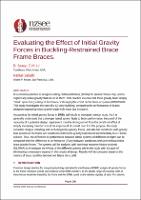Evaluating the Effect of Initial Gravity Forces in Buckling-Restrained Brace Frame Braces

Download
Date
2024-04-09Authors
Saxey, Brandt
Li, Chao-Hsien
Sabelli, Rafael
Metadata
Show full item recordAbstract
It is common practice to design buckling-restrained braces (BRBs) for seismic forces only, and to neglect any initial gravity that occurs in them. This practice assumes that these gravity loads simply “shed” upon first yielding of the braces, with negligible effect on the brace or system performance. This study investigates the case of a 12-story building, comparing the performances of braces designed neglecting initial gravity loads with those that include it.
Accounting for initial gravity forces in BRBs will result in increased member sizes. As it is generally understood that a stronger lateral system leads to better performance, the proof of the necessity of a potential design requirement must be distinguished from the beneficial effect of simply increasing member size at the expense of structural cost. For this purpose, the study considers designs including and excluding brace gravity forces, and also has conditions with gravity load present on the frame and conditions with frame gravity load moved incrementally to a P-Delta column. Thus, the difference in performance between lateral systems of different strengths can be compared with the difference in performance (if any) between conditions with and without initial brace gravity forces. The systems will be analyzed with nonlinear response history analysis (NLRHA) to investigate the effects of the different systems within the study with the goal of eliminating unnecessary expense in the structural design. Results will be compared based on the metrics of brace ductility demand and lateral story drift.
